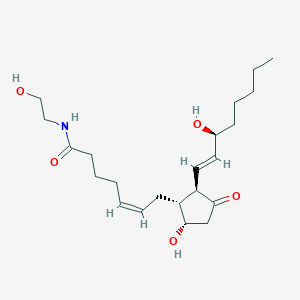Details of Metabolite
| Full List of Protein(s) Regulating This Metabolite | ||||||
|---|---|---|---|---|---|---|
| Hydrolases (EC 3) | ||||||
| Group 10 secretory phospholipase A2 (PLA2G10) | Click to Show/Hide the Full List of Regulating Pair(s): 1 Pair(s) | |||||
| Detailed Information |
Protein Info
 click to show the details of this protein click to show the details of this protein
|
|||||
| Regulating Pair |
Experim Info
 click to show the details of experiment for validating this pair click to show the details of experiment for validating this pair
|
[1] | ||||
| Introduced Variation | Knockout of Pla2g10 | |||||
| Induced Change | PGD2 ethanolamide concentration: decrease | |||||
| Summary | Introduced Variation
|
|||||
| Disease Status | Acute asthma exacerbations [ICD-11: CA23] | |||||
| Details | It is reported that knockout of Pla2g10 leads to the decrease of PGD2 ethanolamide levels compared with control group. | |||||
| Monoacylglycerol lipase ABHD6 (ABHD6) | Click to Show/Hide the Full List of Regulating Pair(s): 1 Pair(s) | |||||
| Detailed Information |
Protein Info
 click to show the details of this protein click to show the details of this protein
|
|||||
| Regulating Pair |
Experim Info
 click to show the details of experiment for validating this pair click to show the details of experiment for validating this pair
|
[2] | ||||
| Introduced Variation | Inhibition (WWL70) of Abhd6 | |||||
| Induced Change | PGD2 ethanolamide concentration: decrease | |||||
| Summary | Introduced Variation
|
|||||
| Disease Status | Healthy individual | |||||
| Details | It is reported that inhibition of Abhd6 leads to the decrease of PGD2 ethanolamide levels compared with control group. | |||||
If you find any error in data or bug in web service, please kindly report it to Dr. Zhang and Dr. Mou.

